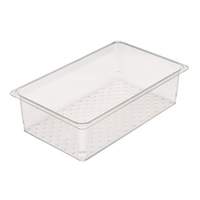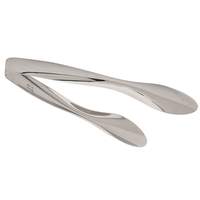Recent shortages in the in plastic resins are beginning to affect foodservice operators. Polysulfone, the primary component in most food safe high heat plastics, has not only seen a dramatic increase in cost, but recent shortages have been so extreme that manufacturers are beginning to discontinue items that feature this plastic. As time goes on, and this shortage continues, both manufacturers and end users will need to start making adjustments.
High Heat Plastic In The Commercial Kitchen
Commercial plastics are used in a number of places in the commercial kitchen, however high heat plastics are not. Food containers and utensils are the most common high heat pieces found in the commercial BOH. The commercial kitchen is an intense work environment for any piece of equipment, and depending on the circumstances, plastics usually don’t fare well. Often times, standard plastic utensils will melt and standard polycarbonate food pans will crack or warp under extreme conditions.
Many manufacturers began producing high heat to give operators an option outside of costly stainless steel pans and utensils. High heat food pans and utensils were similarly priced to many of the other plastic models on the market, but offered customers a far more durable piece. Resistant to heat, scratches, and other standard wear and tear, these items filled a gap in the market for a number of years. As prices continue to rise on raw materials, and manufacturers stop producing them, however, kitchen managers will have to make adjustments.
Alternatives To High Heat Plastic
Foodservice industry operators and managers are now in the precarious position of having to find replacements for the high heat plastic items that may no longer be available. Depending on what specific need these items were filling, operators can find acceptable subs in three standard replacement materials.
- Stainless steel – Nearly all of the kitchen items made of high heat plastic have stainless steel counterparts. Stainless steel is non-reactive, durable, and can handle the extreme heat of the commercial kitchen. There are varying grades of stainless steel products, and though some imports may be cheaper than high heat plastic, they may not be as durable. Be sure to examine the quality of the steel when making this switch.
- Polycarbonate – A strong, often clear plastic, polycarbonate is, in essence, polysulfone’s younger sister. Polycarbonate can be a suitable substitute for polysulfone, as long as operational temperatures are not extreme. Polycarbonate is durable, however it can become brittle in extreme cold conditions (i.e. freezers) and will melt or warp if stored at temperatures over 150 degrees Fahrenheit.
- Silicone – Silicone is a composite flexible polymer with incredible resistance to both heat and cold. It is non-reactive, anti-microbial, and non-stick, but does not have the hardness of plastics like polysulfone or polycarbonate. Silicone is a flexible, and almost rubber like material, which limits the capacities it can be used in. There are a number of various manufacturers that offer utensils, bakeware, and other smallwares manufactured from silicone, however there are few companies that currently produce standard size silicone food pans. Though a bit more expensive than high heat plastic pans, these silicone food pans are far more durable. Often toted as “freezer-to-oven” pans, they usually have a steel wire frame that supports a thick layer of silicone.



